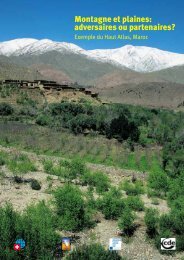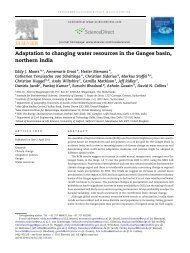Process geomorphology and ecosystems ... - Dendrolab.ch
Process geomorphology and ecosystems ... - Dendrolab.ch
Process geomorphology and ecosystems ... - Dendrolab.ch
- No tags were found...
You also want an ePaper? Increase the reach of your titles
YUMPU automatically turns print PDFs into web optimized ePapers that Google loves.
GEOMOR-04400; No of Pages 3Geomorphology xxx (2013) xxx–xxxContents lists available at SciVerse ScienceDirectGeomorphologyjournal homepage: www.elsevier.com/locate/geomorphEditorial<strong>Process</strong> <strong>geomorphology</strong> <strong>and</strong> <strong>ecosystems</strong>: Disturbance regimes <strong>and</strong> interactionsGeomorphic processes are important agents of ecosystem disturbance,<strong>and</strong> ecosystem functions moderate the magnitude <strong>and</strong> frequencyof geomorphic events. Developing an improved underst<strong>and</strong>ing of theinteractions between geomorphic <strong>and</strong> ecological processes represents akey <strong>ch</strong>allenge for both disciplines, as is exemplified by the large numberof special issues published on the topic in the last few years (Viles <strong>and</strong>Naylor, 2002; Thoms et al., 2007; Hession et al., 2010; Rice et al.,2010; Darby, 2011; Wheaton et al., 2011; Butler <strong>and</strong> Sawyer, 2012;Rice et al., 2012).This special issue contains eleven papers, mostly delivered at asession organized by the guest editors at the European GeosciencesUnion (EGU) General Assembly in Vienna (Austria) in April 2011.The main goals of the session were to bring together resear<strong>ch</strong>ers interestedin (i) quantifying plant <strong>and</strong> animal impacts on geomorphicdisturbance regimes as well as of geomorphic disturbances on aquatic<strong>and</strong> terrestrial <strong>ecosystems</strong>; (ii) elucidating the interactions <strong>and</strong> feedbacksbetween process <strong>geomorphology</strong> <strong>and</strong> <strong>ecosystems</strong> at any scale;<strong>and</strong> in (iii) investigating how <strong>ecosystems</strong> might be used to inferpast geomorphic disturbance histories.In the first paper of this special issue, Coombes et al. focus onthe impacts <strong>and</strong> bioprotective role of seaweed in the intertidalzone. The authors examined the influence of seaweed canopies(Fucus spp.) on near-surface microclimate <strong>and</strong> on conditions forme<strong>ch</strong>anical rock decay <strong>and</strong> under-canopy ecology on artificialcoastal structures built of limestone <strong>and</strong> concrete in South WestEngl<strong>and</strong>. The authors demonstrate that the range <strong>and</strong> maxima ofdaily summertime temperatures were significantly lower (56%<strong>and</strong> 25%, respectively) in areas colonized by seaweed comparedto experimentally cleared areas. Using seaweed as an example,they develop a conceptual model of the relationship between biologicalcover <strong>and</strong> microclimate in the intertidal zone. They concludethat in urban coastal environments, where disturbancetends to occur more frequently, facilitating the establishment <strong>and</strong>recovery of canopy-forming species on rocks <strong>and</strong> engineered structuresmay enhance the durability of construction materials as wellas support conservation, planning, <strong>and</strong> policy targets for biodiversityenhancement.In contrast to these largely hidden zoogeomorphic effects of theintertidal zone, two papers in the special issue focus on the impactof mass-wasting processes on the establishment <strong>and</strong> vitality of forests.Deligne et al. address the repaving of l<strong>and</strong>scapes by effusive volcaniceruptions <strong>and</strong> the associated <strong>ch</strong>allenges for ecological recoverypresented by dense, sterile, inhospitable lava deposits. The studymade use of two sites with recent volcanism in the central OregonCascades <strong>and</strong> used a combination of LiDAR analyses, field observations,<strong>and</strong> soil <strong>ch</strong>aracterization to demonstrate that the presence ofexternal sediment or soil sources, in particular flood-borne depositsor syn- or post-eruptive tephra, facilitates plant establishment,growth, <strong>and</strong> survival. They conclude that the nature of external sedimentsources or soils strongly affects the recovery <strong>and</strong> distribution offorests on young lava flows.The second mass-wasting paper, by Corona et al., addresses interactionsbetween trees <strong>and</strong> rockfall on forested talus slopes.While the presence <strong>and</strong> density of vegetation have a profound influenceon rockfall activity, rockfalls also exert control on the presence,vitality, species composition, <strong>and</strong> age distribution of forestst<strong>and</strong>s. The authors use the interactions between biotic (treegrowth) <strong>and</strong> abiotic (rockfall) processes in a mountain forest togather reliable input data for a 3D model of rockfall on a slope inthe Swiss Alps. They demonstrate that differences between simulated<strong>and</strong> observed numbers of tree impacts can be minimizedthrough a careful definition of active source areas <strong>and</strong> a weighteddistribution of block sizes as observed in the field. The authors concludethat a combination of field-based dendro<strong>geomorphology</strong> <strong>and</strong>modeling approa<strong>ch</strong>es can significantly improve hazard mappingbecause it allows a more reliable spatial <strong>ch</strong>aracterization of rockfallfrequencies, a more realistic representation of past rockfall dynamics<strong>and</strong> an improved underst<strong>and</strong>ing on where <strong>and</strong> how rockfallsdisturb trees <strong>and</strong> forest st<strong>and</strong>s.In an interesting departure from previous work on the biogeomorphicimpact of salmon, Albers <strong>and</strong> Petticrew investigated the role of Pacificsalmon (Oncorhyn<strong>ch</strong>us sp.) on the disturbance <strong>and</strong> redeposition offine sediment during spawning <strong>and</strong> the associated distribution <strong>and</strong>storage of marine derived nutrients (MDN) from salmon death <strong>and</strong>decay. Using experimental enclosures in the Horsefly River spawning<strong>ch</strong>annel in north-central British Columbia, the authors quantified themagnitude of organic <strong>and</strong> inorganic sediment export <strong>and</strong> retentionfrom an active-spawning area <strong>and</strong> determined the contribution of finesediment MDN storage using a suspended sediment mass balancemodel, marine isotope enri<strong>ch</strong>ment <strong>and</strong> a time series of gravel bed sedimentinfiltration. They clearly illustrate that strong linear relationshipsexist between sediment infiltration <strong>and</strong> marine-derived nutrient enri<strong>ch</strong>ment<strong>and</strong> that localized patterns of sediment deposition are regulatedby salmon activity, whi<strong>ch</strong> in turn act to control MDN storagewithin, <strong>and</strong> release from, the gravel bed.The majority of the contributions in this special issue address themutual impacts <strong>and</strong> interdependencies of river dynamics on riparianvegetation with modeling, aerial photography <strong>and</strong> tree-ring reconstructions.Based on a series of flume experiments, Crouzy et al. discuss howthe balance between uprooting by flood events <strong>and</strong> reinforcement byplant roots determines the ability for vegetation to colonize the riverbed.The authors highlight the role of varying local stream power onthese processes <strong>and</strong> illustrate the influence of vegetation root length,number of roots <strong>and</strong> stem height for the survival of vegetation in the0169-555X/$ – see front matter © 2013 Elsevier B.V. All rights reserved.http://dx.doi.org/10.1016/j.geomorph.2013.06.018Please cite this article as: Stoffel, M., et al., <strong>Process</strong> <strong>geomorphology</strong> <strong>and</strong> <strong>ecosystems</strong>: Disturbance regimes <strong>and</strong> interactions, Geomorphology(2013), http://dx.doi.org/10.1016/j.geomorph.2013.06.018
2 Editorialriverbed after a flood. In a model-based assessment of stream processes,woody debris <strong>and</strong> riparian <strong>ecosystems</strong>, Davidson <strong>and</strong> Eaton considerthe consequences of anthropogenic decoupling of streams from riparian<strong>ecosystems</strong> <strong>and</strong> thence wood recruitment processes. The authors used aphysical model to examine the impact of different wood load on <strong>ch</strong>annelmorphology <strong>and</strong> hydraulics. The addition of large wood significantlydecreased the rea<strong>ch</strong>-averaged velocity in all experiments, <strong>and</strong> was associatedwith decreased sediment transport <strong>and</strong> increased sediment storagein the rea<strong>ch</strong>. Increases in bed <strong>and</strong> water surface slope were shownto compensate for the loss of energy available to transport sediment,<strong>and</strong> to enable the system to rea<strong>ch</strong> a new steady state within 6 to9 years. The retention of fine sediment was shown to increase the availabilityof spawning substrate, while increased water stage improvedfloodplain connectivity. The authors illustrate that the <strong>ch</strong>anges in habitatcomplexity were generally related to the wood load added to therea<strong>ch</strong>, but that they also depended on the orientation <strong>and</strong> arrangementof the pieces.Henshaw et al. utilize multispectral L<strong>and</strong>sat satellite data to investigatethe interactions between fluvial processes <strong>and</strong> riparian vegetationalong the Tagliamento river (NE Italy) over the past 30 years,with the aim to evaluate the degree to whi<strong>ch</strong> remotely sensed datacan support the assessment of fluvial dynamics. The authors focuson spatio-temporal trends in vegetation cover <strong>and</strong> <strong>ch</strong>annel positionat six sites <strong>and</strong> interpret observed <strong>ch</strong>anges using a series of hydromorphicdata <strong>and</strong> survey-based biogeomorphic <strong>ch</strong>aracteristics fromthe study sites. They nicely illustrate the limitations of L<strong>and</strong>sat TMdata, whi<strong>ch</strong> are mostly related to its relatively low spatial resolution,including geomorphic feature definition <strong>and</strong> active tract delineation,but also demonstrate that L<strong>and</strong>sat TM data can indeed reveal a wealthof information that could support further biogeomorphic investigationsin other large rivers. The paper by Little et al. is also based onphoto interpretation, but uses a 70-year aerial photo record <strong>and</strong>field data from the Carmanah River valley, Vancouver Isl<strong>and</strong>, BritishColumbia to study the diverse, shifting mosaic of forest pat<strong>ch</strong>es inan alluvial forest <strong>and</strong> examine the hydrogeomorphic disturbance regimethat structures it. Resear<strong>ch</strong> was based on a l<strong>and</strong>scape-scale analysisto quantify historical <strong>ch</strong>annel migrations <strong>and</strong> <strong>ch</strong>anges in theextent of specific forest types. The findings support a general conceptualmodel describing cycles of pat<strong>ch</strong> development <strong>and</strong> destruction inunconfined alluvial forests of the Pacific Coastal Ecoregion. They alsodemonstrate that Carmanah River has eroded nearly 30% of the alluvialforest in the course of the 20th century, <strong>and</strong> approximately 65%over the past 500 years. Interestingly, younger l<strong>and</strong>forms were apparentlydisturbed more frequently than mature forest pat<strong>ch</strong>es,suggesting that the likelihood of future disturbance decreases asbiogeomorphic succession progresses. In addition, the authors concludethat larger floods, predicted to occur more frequently with climate<strong>ch</strong>ange, might <strong>ch</strong>ange the disturbance regime of floodplainforests <strong>and</strong> alter l<strong>and</strong>scape composition.Stella et al. consider how hydrogeomorphic <strong>ch</strong>anges affect key biological<strong>and</strong> physical processes that sustain riparian ecosystem health<strong>and</strong> constrain potential recovery. Working on the Drôme River, southernFrance, the authors study ecosystem response to <strong>ch</strong>annel incisiondue to gravel mining using tree-ring series from Populus nigra, a ripariantree vulnerable to <strong>ch</strong>anges in local hydrology. Cores collected at sevenfloodplain sites were used to investigate the severity <strong>and</strong> timing oflocal growth decline along the river. Regime shift analysis of thetree-ring series indicates that tree growth declined significantly atfour sites since 1978, coinciding with documented <strong>ch</strong>annel incision. Inaddition, patterns of low growth <strong>and</strong> crown dieback are consistentwith stress due to reduced water supply. However, the most impairedsites were not directly adjacent to local mining pits, <strong>and</strong> initiation ofgrowth declines was most typically associated with drought years inthese cases. In any case, the authors show quite clearly that riparian forestsare vulnerable to hydrogeomorphic <strong>ch</strong>anges, but that the severityof impacts is likely to be conditioned by interactions between driversat different scales, including regional climate variability, rea<strong>ch</strong>-basedgeomorphic alteration, <strong>and</strong> local lithological controls.The contribution of Mikus et al. showcases results of long-termobservations conducted in the gravel-bed river Czarny Dunajec,Polish Carpathians. The authors use morphological <strong>and</strong> botanicalsurveys to determine processes <strong>and</strong> patterns whi<strong>ch</strong> govern the initiation<strong>and</strong> development of isl<strong>and</strong>s <strong>and</strong> their floristic complexity.Tree-ring records of riparian vegetation were used to date isl<strong>and</strong> inception<strong>and</strong> compared with the timing <strong>and</strong> magnitude of flood flowsbetween 1970 <strong>and</strong> 2011. The authors show that in this high-energybraided river, isl<strong>and</strong>s originate through the deposition of largewood on gravel bars <strong>and</strong> the associated vegetative regeneration ofliving wood or the growth of seedlings in the shelter of wood accumulations.After 1997 the occurrence of low to moderate floods facilitatedthe formation <strong>and</strong> persistence of isl<strong>and</strong>s where speciesri<strong>ch</strong>ness increased non-linearly with increasing age, area <strong>and</strong> shorelength of isl<strong>and</strong>s. They also highlight that these isl<strong>and</strong>s substantiallyaugment the overall floristic complexity of river corridor <strong>and</strong> thattheir re-establishment should be viewed as an important factor inthe restoration of degraded mountain rivers.The last paper in the special issue focuses on the relations betweenvegetation <strong>and</strong> sediment transport processes at FishtrapCreek, British Columbia, where a fire burnt 62% of the basin's forestin 2003. Based on the analysis of local streamflow data <strong>and</strong>suspended sediment fluxes in comparison with nearby JamiesonCreek, whi<strong>ch</strong> was not affected by the wildfire, Owens et al. observethat peak streamflows in Fishtrap Creek after the wildfire were notsignificantly higher than before the wildfire, but that total annualrunoff had increased. After the wildfire, monthly total suspendedsediment fluxes peaked in April in Fishtrap Creek <strong>and</strong> May inJamieson Creek, whi<strong>ch</strong> reflects a <strong>ch</strong>ange in the timing of peakstreamflow at the burnt site. Specific suspended sediment yieldswere low in the first year following fire <strong>and</strong> peaked in 2006, presumablyreflecting a lack of winter precipitation <strong>and</strong> low intensities ofsummer rainfall events in the first year following the wildfire. Greaterwinter precipitation <strong>and</strong> associated snowmelt in subsequent yearscoincided with vegetation recovery. Interestingly, major <strong>ch</strong>anges inthe wildfire-affected watershed included increased bank erosion<strong>and</strong> <strong>ch</strong>annel migration caused by a loss of root strength <strong>and</strong> cohesion,3–5 years after the fire.Together, these eleven papers yet again exemplify the wide rangeof interesting resear<strong>ch</strong> questions sitting at the interface of ecology<strong>and</strong> <strong>geomorphology</strong>. Geomorphic processes affect ecologic systems,<strong>and</strong> flora <strong>and</strong> fauna can modulate the rate of occurrence <strong>and</strong> the impactof geomorphic disturbance events. In addition, <strong>ecosystems</strong> mayrecord the geomorphic history of a region, <strong>and</strong> provide ar<strong>ch</strong>ives thatare rarely exploited to date.AcknowledgmentsThe guest editors of this special issue wish to thank the reviewersof the papers that have contributed to this special issue <strong>and</strong> our editorAdrian Harvey. Their hard work <strong>and</strong> helpful commentaries improvedea<strong>ch</strong> manuscript.ReferencesButler, D.R., Sawyer, C.F. (Eds.), 2012. Zoo<strong>geomorphology</strong> <strong>and</strong> ecosystemengineeringGeomorphology 157–158 (191 pp.).Darby, S.E., 2011. Reappraising the <strong>geomorphology</strong>–ecology link. Earth Surface <strong>Process</strong>es<strong>and</strong> L<strong>and</strong>forms 35, 368–371.Hession, W.C., Curran, J.C., Resler, L.M. (Eds.), 2010. Geomorphology <strong>and</strong> vegetation: interactions,dependencies, <strong>and</strong> feedback loopsGeomorphology 116 (3-4) (170 pp.).Rice, S.P., Little, S., Wood, P.J., Moir, H.J., Vericat, D., 2010. The relative contributions ofecology <strong>and</strong> hydraulics to ecohydraulics. River Resear<strong>ch</strong> <strong>and</strong> Applications 26,363–366.Rice, S.P., Stoffel, M., Turowski, J.M., Wolf, A., 2012. Disturbance regimes at the interface of<strong>geomorphology</strong> <strong>and</strong> ecology. Earth Surface <strong>Process</strong>es <strong>and</strong> L<strong>and</strong>forms 37, 1678–1682.Please cite this article as: Stoffel, M., et al., <strong>Process</strong> <strong>geomorphology</strong> <strong>and</strong> <strong>ecosystems</strong>: Disturbance regimes <strong>and</strong> interactions, Geomorphology(2013), http://dx.doi.org/10.1016/j.geomorph.2013.06.018
Editorial3Thoms, M.C., Rens<strong>ch</strong>ler, C.S., Doyle, M.W. (Eds.), 2007. 36th Binghamton Symposium:<strong>geomorphology</strong> <strong>and</strong> <strong>ecosystems</strong>Geomorphology 89 (1-2) (239 pp.).Viles, H.A., Naylor, L.A. (Eds.), 2002. Bio<strong>geomorphology</strong>Geomorphology 47 (94 pp.).Wheaton, J.M., Gibbons, C., Wainwright, J., Larsen, L., McElroy, B., 2011. Preface:multiscale feedbacks in eco<strong>geomorphology</strong>. Geomorphology 126, 265–268.Markus Stoffel<strong>Dendrolab</strong>.<strong>ch</strong>, Institute for Geological Sciences, University of Berne,Baltzerstrasse 1+3, 3012 Berne, Switzerl<strong>and</strong>Institute for Environmental Sciences, University of Geneva,Route de Drize 7, 1227 Carouge, Switzerl<strong>and</strong>Corresponding author at: <strong>Dendrolab</strong>.<strong>ch</strong>, Institute for GeologicalSciences, University of Berne, Baltzerstrasse 1+3, 3012 Berne,Switzerl<strong>and</strong>. Tel.: +41 31 631 87 73; 41 31 631 48 43.E-mail address: markus.stoffel@dendrolab.<strong>ch</strong>.Stephen RiceCentre for Hydrological <strong>and</strong> Ecosystem Science,Loughborough University, Loughborough LE11 3TU, UKJens M. TurowskiSection 5.1 Geomorphology, Helmholtz Centre Potsdam,GFZ German Resear<strong>ch</strong> Centre for Geosciences, Albert-Einstein-Straße 48,14473 Potsdam, GermanyMountain Hydrology <strong>and</strong> Mass Movements,Swiss Federal Resear<strong>ch</strong> Institute WSL, Zür<strong>ch</strong>erstrasse 111,8903 Birmensdorf, Switzerl<strong>and</strong>Available online xxxxPlease cite this article as: Stoffel, M., et al., <strong>Process</strong> <strong>geomorphology</strong> <strong>and</strong> <strong>ecosystems</strong>: Disturbance regimes <strong>and</strong> interactions, Geomorphology(2013), http://dx.doi.org/10.1016/j.geomorph.2013.06.018






